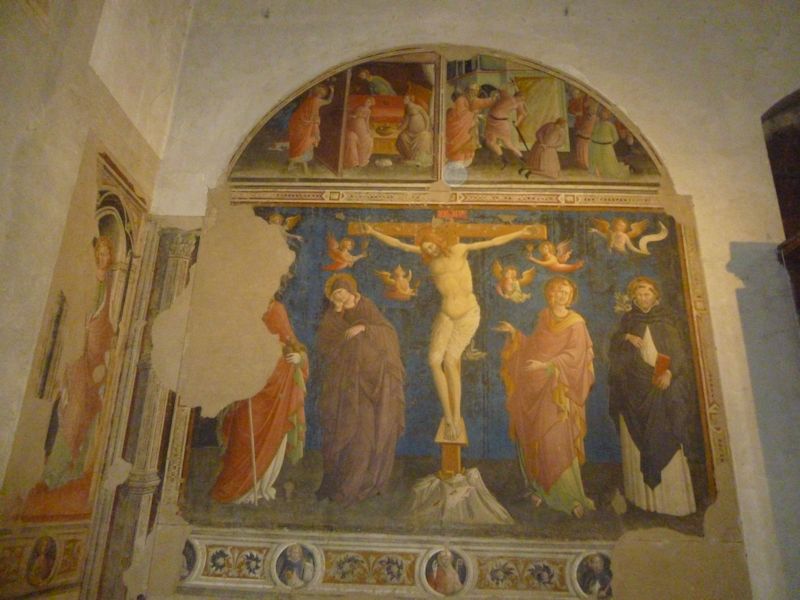You may not find this terribly rewarding unless you're included here, so this is a good time for casual and random browsers to turn back before they get too caught up in the sweep and majesty of the proceedings and can't let go.
We've spent the day roaming the city streets in search of amusing antiques to not buy, and the afternoon is getting on.
-- Where to now?

The Chiesa di Santi Michele e Adriano, off the Corso Italia -- originally a Lombard building, but first documented in 1095, it was redone in the Gothic style in the early 14th century and again in the 15th. And then again in 1934.

Jesus on his throne in the tympanum

I recognize that hand

A dark and moody interior, perfect for sinners who wish to contemplate their sins undisturbed . . .

. . . but we're just here to view the artwork.

Like this nice one.

Lunchtime in the Fior di Pizza next door

Arezzo street scene

Ubiquitous prompts to piety, and a convenient shelter from rainshowers

We're heard rumors (from our hostess) that we can also get to our room in the Corte dei Re through the roof . . .

. . . via this public park way above the Piazza Grande.

Our hostess was correct.

Ouch. I'm awful going downhill on stairways.

Kristin's antiqued out for the day, and I yearn to visit the Medici Fortress at the city summit.

The Fortezza Medicea, or Medici Fortress, was stuck up here by the Florentines in the mid-16th century (1538 to 1560) to replace the old medieval citadel, which was considered to be unsuitable for the new age of cannon fire.

The fortress is built solidly into the city wall, very strong facing out towards potential foreign attackers, equally strong facing down into the city (just in case).

The fortress was in good nick when Napoleon and his friends captured the city in 1800 and largely dismantled much of it and blew up the rest. A lot of good it did them: Arezzo became the centre of the Tuscan "Viva Maria" wing of the Sanfedisti anti-French resistance movement (choose one: 1. brave patriots opposed to foreign occupation, or 2. peasant religious fanatics opposed to French egalitarian republican ideals).

Here's the front door. Closed for repairs. Come back next year.

Tuscan countryside to the north

Past the cathedral and down the hill, here's the beautiful, asymmetrical Basilica of San Domenico.

Construction was begun in 1275 and can't have taken too long; this looks fairly straightforward, but of course there's a huge monastic complex to go with it.

Some great frescoes just inside the front door, by Spinello Aretino and his son Parri di Spinello; in the latter's Crucifixion above, St Dominic is on the right (who either was or was not the founder of the Inquisition).

Saints Philip and James the Lesser (ca. 1395)

Some of them could use a little sprucing up.

A little Gothic mini-chapel on the wall, from the Dragomanni family, sculpted in 1368, with a fresco of Jesus explaining theology to the Doctor of the Temple

People flock from all over the world to the San Domenico to see this: a crucifix painted by Cimabue in 1265. Thoughtfully backlit by the management. (I'm going to try again later in the week, but no promises.)


Round the back of the San Domenico church

The Chiesa di San Domenico

Down the street a ways (I'm church-hopping now), this is the Santa Maria in Gradi -- the monastery and church dates from the mid-11th century, but this was thoroughly redone by the Camaldolese Benedictines between 1591 and 1611.

A single nave with 17th century side chapels; nothing that I find interesting, but in fairness I'm hurrying through.

An Andrea della Robbia knock-off by one of his devoted colleagues

In the cute little crypt, that's a wooden crucifix from the late 1200s.

Moving right along: the Chiesa della Santissima Annunziata on the Via Garibaldi; promising so far.

That's an interesting Annunciation, open to the elements, by Spinello Aretino, during his Aretine period (1360-1384), probably about 1370.

The church was originally built, beginning in 1491, to house a miraculous statue of the Madonna, which if you squint you can see now suitably housed in the main altar.

The quite nice statue had stood in the lobby of a local hospital, unobtrusively, until in February 1490 when a young fellow from La Spezia, returning from a visit to Loreto, started praying to the statue and the statue began weeping. So they built the church to accommodate this special bit of local history.

Terra cotta Madonna and baby with St Francis and St Rocco (showing off his buboes on the right), by Agnolo di Polo, a disciple of Verrocchio, late 15th century

This Deposition of Christ painting, which it's difficult to see from this distance, is by Vasari.

One more stop for today in our Round-Up of Churches

Badia delle Sante Flora e Lucilla, or abbey church dedicated to the third century martyred sisters Flora and Lucilla, whose relics were brought here by the then-Bishop of Arezzo, John. Saints Flora and Lucilla, alas, became ex-Saints in 2001.

The church was begun in 1278 as part of a Benedictine monastery, but completely redone beginning in 1565 with designs by Giorgio Vasari and continuing into the next century. The octagonal belltower was added in 1650.

The dome above the backlit altar looks interesting, but it's not; a dome, that is.

It's a fake dome painted on canvas by Andrea Pozzo in 1702 (could have fooled me; in fact it did; Kristin pointed this out the next day).

St Lawrence showing off his gridiron again; a fresco from 1476 by Bartolomeo della Gatta

Back up the Corso Italia towards the Pieve Santa Maria on the right . . .

. . . and back to the room to begin the pre-dinner warm-up.
 Dwight Peck's personal website
Dwight Peck's personal website






























































